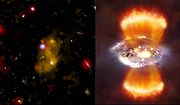
Lyman-alpha blob
Encyclopedia

Astronomy
Astronomy is a natural science that deals with the study of celestial objects and phenomena that originate outside the atmosphere of Earth...
, a Lyman-alpha blob (LAB) is a huge concentration of a gas emitting the Lyman-alpha emission line
Lyman-alpha line
In physics, the Lyman-alpha line, sometimes written as Ly-\alpha line, is a spectral line of hydrogen, or more generally of one-electron ions, in the Lyman series, emitted when the electron falls from the n = 2 orbital to the n = 1 orbital, where n is the principal quantum number...
. LABs are some of the largest known individual objects in the Universe
Universe
The Universe is commonly defined as the totality of everything that exists, including all matter and energy, the planets, stars, galaxies, and the contents of intergalactic space. Definitions and usage vary and similar terms include the cosmos, the world and nature...
. Some of these gaseous structures are more than 400,000 light years across. So far they have only been found in the high-redshift
Redshift
In physics , redshift happens when light seen coming from an object is proportionally increased in wavelength, or shifted to the red end of the spectrum...
universe because of the ultraviolet
Ultraviolet
Ultraviolet light is electromagnetic radiation with a wavelength shorter than that of visible light, but longer than X-rays, in the range 10 nm to 400 nm, and energies from 3 eV to 124 eV...
nature of the Lyman-alpha emission line. Since the Earth's atmosphere
Earth's atmosphere
The atmosphere of Earth is a layer of gases surrounding the planet Earth that is retained by Earth's gravity. The atmosphere protects life on Earth by absorbing ultraviolet solar radiation, warming the surface through heat retention , and reducing temperature extremes between day and night...
is very effective at filtering out UV photon
Photon
In physics, a photon is an elementary particle, the quantum of the electromagnetic interaction and the basic unit of light and all other forms of electromagnetic radiation. It is also the force carrier for the electromagnetic force...
s, the Lyman-alpha photons must be redshifted in order to be transmitted through the atmosphere.
The most famous Lyman-alpha Blobs were discovered in 2000 by Steidel et al. Matsuda et al., using the Subaru Telescope of the National Astronomical Observatory of Japan
National Astronomical Observatory of Japan
The is an astronomical research organisation comprising several facilities in Japan, as well as an observatory in Hawaii. It was established in 1988 as an amalgamation of three existing research organizations - the Tokyo Astronomical Observatory of the University of Tokyo, International Latitude...
extended the search for LABs and found over 30 new LABs in the original field of Steidel et al., although they were all smaller than the originals. These LABs form a structure which is more than 200 million light-years in extent. It is currently unknown whether LABs trace overdensities of galaxies in the high-redshift universe (as high redshift radio galaxies — which also have extended Lyman-alpha halos — do, for example), nor which mechanism produces the Lyman-alpha emission line, or how the LABs are connected to the surrounding galaxies. Lyman-alpha Blobs may hold valuable clues for scientists to determine how galaxies are formed.
The most massive Lyman-alpha blobs have been discovered by Steidel et al. (2000), Francis et al. (2001), Matsuda et al. (2004), Dey et al. (2005), Nilsson et al. (2006), and Smith & Jarvis et al. (2007)
Examples
- Himiko Lyman-alpha blobHimiko Lyman-alpha blobHimiko is a large gas cloud found at redshift of z=6.6 that predates similar Lyman-alpha blobs. Researchers say it "may represent the most massive object ever discovered in the early universe." It is 12.9 billion light years from Earth, or about miles ....
- LAB-1
See also
- Lyman-alpha forestLyman-alpha forestIn astronomical spectroscopy, the Lyman-alpha forest is the sum of absorption lines arising from the Lyman-alpha transition of the neutral hydrogen in the spectra of distant galaxies and quasars....
- Lyman-alpha emitter
- Lyman break galaxy
- Damped Lyman-alpha system
- Newfound blobNewfound BlobThe Newfound Blob is a formation measuring 200 million light-years in width. It is currently the biggest known object in the universe. Discovered in 2006 by Ryosuke Yamauchi from Tohoku University in Sendai, Japan, and his colleagues, the structure was found in a region of the universe known to...

